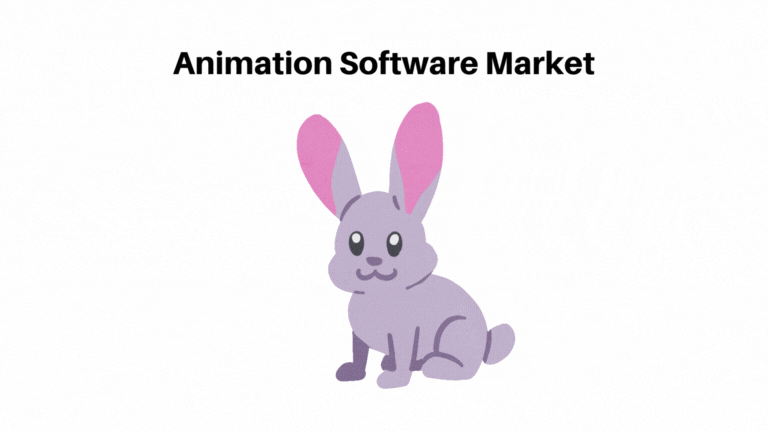Animation Software Market Size USD 10.5 Bn by 2032| at a CAGR 15.1%

Page Contents
Market Overview
Published Via 11Press: In 2022, the global Animation Software Market was valued at USD 2.6 Bn and is projected to grow at a compound annual growth rate (CAGR) of 15.1% from 2022-2032, reaching a value of USD 10.5 Bn by 2032. The increasing demand for 3D animations, visual effects, and gaming is fueling this growth in the animation software market.
The market is segmented based on type, application, and region. By type, there are 2D animation, 3D animation, and others; 3D animation is the largest segment due to its growing demand in entertainment industries, advertising campaigns, and education initiatives.
On the basis of application, the market is divided into media and entertainment, education & training, healthcare & life sciences, and others. The latter segment accounts for the largest share due to the increasing use of animation software in films, TV shows, and video games.
North America is the leading market for animation software, followed by Europe and Asia Pacific. This growth in North American demand is attributed to a number of major animation software vendors as well as an established media and entertainment industry.
Some of the key players in the animation software market include Adobe Inc., Autodesk Inc., Corel Corporation, Toon Boom Animation Inc., and The Foundry Visionmongers Ltd. These companies are investing heavily in product innovation and strategic partnerships to increase their market share and access new customers.

Drivers, trends, and challenges have an impact on market dynamics, which can impact businesses. Request for PDF sample report
Key Takeaways
- The global animation software market is projected to grow at a compound annual growth rate (CAGR) of 15.1% from 2022-2032, reaching a value of USD 10.5 billion by 2032.
- The rising demand for 3D animations, visual effects, and gaming is fueling this growth in the animation software market.
- 3D animation has become the largest segment, due to its growing demand in entertainment, advertising, and education.
Regional Snapshot
- North America is the leading market for animation software, thanks to major animation software vendors and an established media and entertainment industry.
- Europe is the second-largest market, driven by an increase in 3D animation production within the region's entertainment industry.
- The Asia Pacific region is expected to experience the fastest growth, driven by the increasing adoption of animation software within media and entertainment industries as well as expansion in gaming activity within this region.
Drivers
- Growing Demand for Animation in the Entertainment Industry: The entertainment sector, including movies, television shows, and video games, has seen a marked growth in demand for animation software. With these industries enjoying increasing popularity worldwide, manufacturers are eager to meet this rising need.
- 3D Animation's Rapid Adoption: 3D animation has seen a tremendous surge in recent years due to its capacity for producing more realistic and captivating animations. This has resulted in an exponential rise in demand for 3D animation software packages.
- Increased Demand for Visual Effects: Visual effects are an integral component of movies, TV shows, and video games. As the demand for high-quality visual effects continues to grow, so too does the demand for animation software.
- Animation Software in Education and Training: Animation software is increasingly being utilized in educational settings to create engaging, interactive learning materials. This has resulted in an enormous growth in demand for animation software within this sector.
- Technological Advancements in Animation Software: As new technologies such as cloud computing, AI, and machine learning become available, advanced animation software is being created that produces higher-quality animations quickly and efficiently. This has led to an increase in demand for programs that can efficiently produce high-quality animations.
Restraints
- High Cost of Animation Software: Animation software can be costly, particularly for small and medium-sized enterprises (SMEs) or independent creators. This poses a barrier to adoption and limits the growth of the market.
- Lack of Skilled Professionals: Animation software requires specialized skills to operate optimally, and the shortage of experienced personnel in the animation industry could hinder its adoption.
- The threat of Piracy: The animation industry is vulnerable to piracy, which could mean lost revenues for animation software vendors and studios. This could deter investment in the sector and limit market expansion.
- High System Requirements: Animation software typically requires high-end hardware and software specifications in order to run optimally, which may put off those with limited resources from adopting it.
- Competition from open-source software: Open-source animation programs such as Blender are becoming increasingly popular with independent creators and small to medium-sized enterprises (SMEs), potentially decreasing the market share for commercial animation software vendors.
- Impact of COVID-19 Pandemic: The COVID-19 pandemic has had a devastating impact on the media and entertainment industry, which is an important consumer of animation software. Furthermore, supply chain disruptions and reduced investments in this sector could potentially impact market growth in the short run.
Opportunities
- Growing Adoption of Animation Software in Healthcare: Animation software is increasingly being utilized within healthcare for patient education, medical training, and visualization. This presents an opportunity for animation software vendors to expand their services into this sector.
- Growing Demand for Animation in Advertising: Animation is increasingly being utilized in advertising to create captivating and interactive ads. This presents an opportunity for animation software vendors to expand their services into the advertising sector.
- Emerging Markets: Emerging economies such as India, China, and Brazil are experiencing rapid expansion of the media and entertainment industry, driving demand for animation software in these regions.
- Integration with Other Technologies: Animation software can be integrated with other technologies like virtual reality (VR) and augmented reality (AR), creating more immersive experiences. This presents animation software vendors with the chance to expand into VR and AR markets.
- Subscription-Based Models: Subscription models are becoming more and more commonplace among animation software vendors, providing recurring revenue streams and reducing upfront costs for customers. This presents animation software vendors with the chance to provide more flexible pricing models.
Challenges
- Growing Competition: The animation software market is becoming more and more crowded, with new entrants and open-source alternatives challenging established vendors. This makes it difficult for animation software providers to differentiate their offerings and maintain market share.
- Intellectual Property Protection: The animation industry is particularly vulnerable to intellectual property theft, with animation software becoming a prime target for pirates. This could result in lost revenues for software vendors and studios, potentially hindering investment in the sector.
- Rapidly Evolving Technology: The animation industry is rapidly developing, with new technologies and techniques emerging every day. This makes it challenging for software vendors to stay abreast of the most recent trends and maintain a competitive edge.
- Lack of Skilled Professionals: The animation industry desperately needs skilled professionals to produce high-quality animations, yet there is a shortage of talent in this sector. This could limit software adoption and make it challenging for animation studios to keep up with demand.
- Limited customer budgets: Animation software can be expensive, and customers may have limited funds for software purchases. This makes it challenging for animation software vendors to sell their products to customers and restricts the growth of the market.
Recent Developments
- On February 2022, Adobe released its most recent version of animation software, Adobe Animate CC, featuring support for virtual reality (VR) and augmented reality (AR) content creation.
- On January, 2022, Toon Boom Animation Inc. unveiled Harmony 22, their most up-to-date animation software version with an improved user interface and superior performance.
- Autodesk Inc. recently unveiled Maya 2022, their newest animation software version that offers a modernized user interface and enhanced animation tools.
- On November, 2021, Maxon announced the acquisition of Red Giant, a provider of motion graphics and visual effects software. This acquisition is expected to bolster Maxon's position within the animation software market.
- On October, 2021, Epic Games announced their acquisition of Sketchfab, a platform for creating, publishing, and sharing 3D content. This acquisition is expected to further bolster Epic Games' position within the animation software market.
Key Market Segments
Type
- 2D Animation
- 3D Animation
- Online Animation
- Other Animation Software
Application
- Individual Users
- Enterprises
- Others
Key Market Players
- Adobe Systems(US)
- Serif(UK)
- HI Corporation(JP)
- Autodesk(US)
- Nemetschek(DE)
- Side Effects Software(AU)
- Reallusion(TW)
- NewTek(US)
- Zygote Media Group Inc(US)
- Smith Micro Software(US)
- The Foundry Visionmongers(UK)
- PMG Worldwide(US)
- Powtoon
Report Scope
| Report Attribute | Details |
| The market size value in 2022 | USD 2.6 Bn |
| Revenue forecast by 2032 | USD 10.5 Bn |
| Growth Rate | CAGR Of 15.10% |
| Regions Covered | North America, Europe, Asia Pacific, Latin America, and Middle East & Africa, and Rest of the World |
| Historical Years | 2017-2022 |
| Base Year | 2022 |
| Estimated Year | 2023 |
| Short-Term Projection Year | 2028 |
| Long-Term Projected Year | 2032 |
Frequently Asked Question
Q: What is animation software?
A: Animation software is a type of software that is used to create animations, which are sequences of images that create the illusion of movement.
Q: What are some popular animation software programs?
A: Some popular animation software programs include Adobe Animate CC, Toon Boom Harmony, Autodesk Maya, Maxon Cinema 4D, and Blender.
Q: What industries use animation software?
A: Animation software is used in a variety of industries, including film and television, video games, advertising, healthcare, and education.
Q: What skills are required to use animation software?
A: Using animation software requires skills such as 2D and 3D animation, rigging, character design, and storytelling.
Q: How is animation software priced?
A: Animation software is typically priced on a per-user or per-seat basis, with prices ranging from a few hundred dollars to several thousand dollars per license. Some animation software vendors also offer subscription-based pricing models.
The team behind market.us, marketresearch.biz, market.biz and more. Our purpose is to keep our customers ahead of the game with regard to the markets. They may fluctuate up or down, but we will help you to stay ahead of the curve in these market fluctuations. Our consistent growth and ability to deliver in-depth analyses and market insight has engaged genuine market players. They have faith in us to offer the data and information they require to make balanced and decisive marketing decisions.



